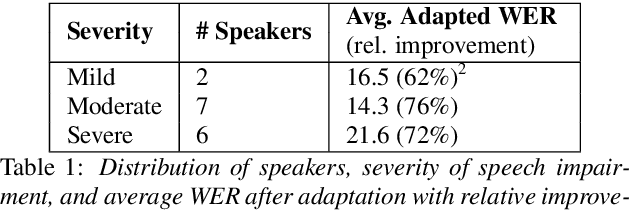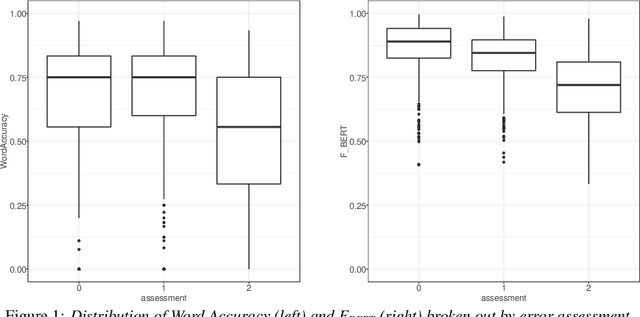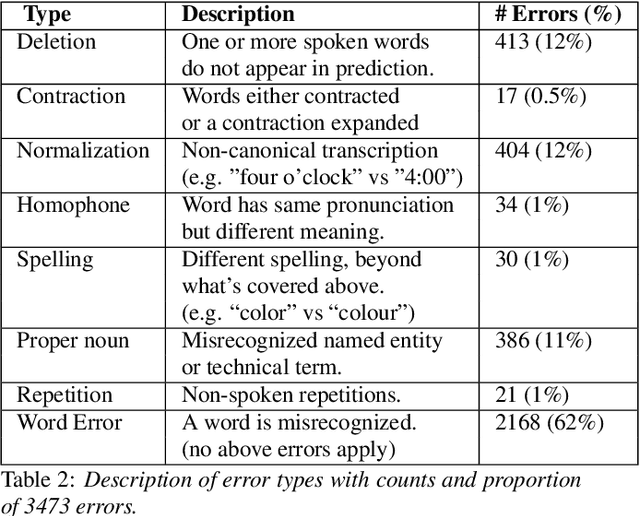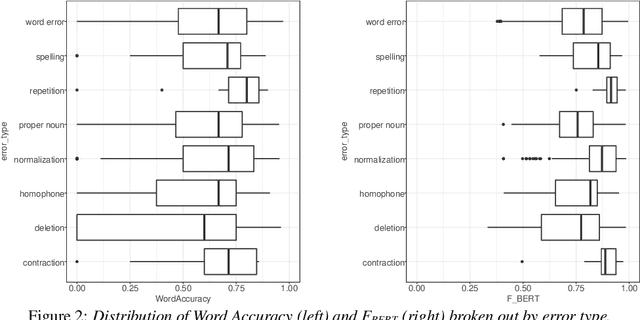Katie Seaver
Learnings from curating a trustworthy, well-annotated, and useful dataset of disordered English speech
Sep 13, 2024Abstract:Project Euphonia, a Google initiative, is dedicated to improving automatic speech recognition (ASR) of disordered speech. A central objective of the project is to create a large, high-quality, and diverse speech corpus. This report describes the project's latest advancements in data collection and annotation methodologies, such as expanding speaker diversity in the database, adding human-reviewed transcript corrections and audio quality tags to 350K (of the 1.2M total) audio recordings, and amassing a comprehensive set of metadata (including more than 40 speech characteristic labels) for over 75\% of the speakers in the database. We report on the impact of transcript corrections on our machine-learning (ML) research, inter-rater variability of assessments of disordered speech patterns, and our rationale for gathering speech metadata. We also consider the limitations of using automated off-the-shelf annotation methods for assessing disordered speech.
Using Large Language Models to Accelerate Communication for Users with Severe Motor Impairments
Dec 03, 2023



Abstract:Finding ways to accelerate text input for individuals with profound motor impairments has been a long-standing area of research. Closing the speed gap for augmentative and alternative communication (AAC) devices such as eye-tracking keyboards is important for improving the quality of life for such individuals. Recent advances in neural networks of natural language pose new opportunities for re-thinking strategies and user interfaces for enhanced text-entry for AAC users. In this paper, we present SpeakFaster, consisting of large language models (LLMs) and a co-designed user interface for text entry in a highly-abbreviated form, allowing saving 57% more motor actions than traditional predictive keyboards in offline simulation. A pilot study with 19 non-AAC participants typing on a mobile device by hand demonstrated gains in motor savings in line with the offline simulation, while introducing relatively small effects on overall typing speed. Lab and field testing on two eye-gaze typing users with amyotrophic lateral sclerosis (ALS) demonstrated text-entry rates 29-60% faster than traditional baselines, due to significant saving of expensive keystrokes achieved through phrase and word predictions from context-aware LLMs. These findings provide a strong foundation for further exploration of substantially-accelerated text communication for motor-impaired users and demonstrate a direction for applying LLMs to text-based user interfaces.
Speech Intelligibility Classifiers from 550k Disordered Speech Samples
Mar 15, 2023Abstract:We developed dysarthric speech intelligibility classifiers on 551,176 disordered speech samples contributed by a diverse set of 468 speakers, with a range of self-reported speaking disorders and rated for their overall intelligibility on a five-point scale. We trained three models following different deep learning approaches and evaluated them on ~94K utterances from 100 speakers. We further found the models to generalize well (without further training) on the TORGO database (100% accuracy), UASpeech (0.93 correlation), ALS-TDI PMP (0.81 AUC) datasets as well as on a dataset of realistic unprompted speech we gathered (106 dysarthric and 76 control speakers,~2300 samples).
An analysis of degenerating speech due to progressive dysarthria on ASR performance
Oct 31, 2022Abstract:Although personalized automatic speech recognition (ASR) models have recently been designed to recognize even severely impaired speech, model performance may degrade over time for persons with degenerating speech. The aims of this study were to (1) analyze the change of performance of ASR over time in individuals with degrading speech, and (2) explore mitigation strategies to optimize recognition throughout disease progression. Speech was recorded by four individuals with degrading speech due to amyotrophic lateral sclerosis (ALS). Word error rates (WER) across recording sessions were computed for three ASR models: Unadapted Speaker Independent (U-SI), Adapted Speaker Independent (A-SI), and Adapted Speaker Dependent (A-SD or personalized). The performance of all three models degraded significantly over time as speech became more impaired, but the performance of the A-SD model improved markedly when it was updated with recordings from the severe stages of speech progression. Recording additional utterances early in the disease before speech degraded significantly did not improve the performance of A-SD models. Overall, our findings emphasize the importance of continuous recording (and model retraining) when providing personalized models for individuals with progressive speech impairments.
Assessing ASR Model Quality on Disordered Speech using BERTScore
Sep 21, 2022



Abstract:Word Error Rate (WER) is the primary metric used to assess automatic speech recognition (ASR) model quality. It has been shown that ASR models tend to have much higher WER on speakers with speech impairments than typical English speakers. It is hard to determine if models can be be useful at such high error rates. This study investigates the use of BERTScore, an evaluation metric for text generation, to provide a more informative measure of ASR model quality and usefulness. Both BERTScore and WER were compared to prediction errors manually annotated by Speech Language Pathologists for error type and assessment. BERTScore was found to be more correlated with human assessment of error type and assessment. BERTScore was specifically more robust to orthographic changes (contraction and normalization errors) where meaning was preserved. Furthermore, BERTScore was a better fit of error assessment than WER, as measured using an ordinal logistic regression and the Akaike's Information Criterion (AIC). Overall, our findings suggest that BERTScore can complement WER when assessing ASR model performance from a practical perspective, especially for accessibility applications where models are useful even at lower accuracy than for typical speech.
 Add to Chrome
Add to Chrome Add to Firefox
Add to Firefox Add to Edge
Add to Edge